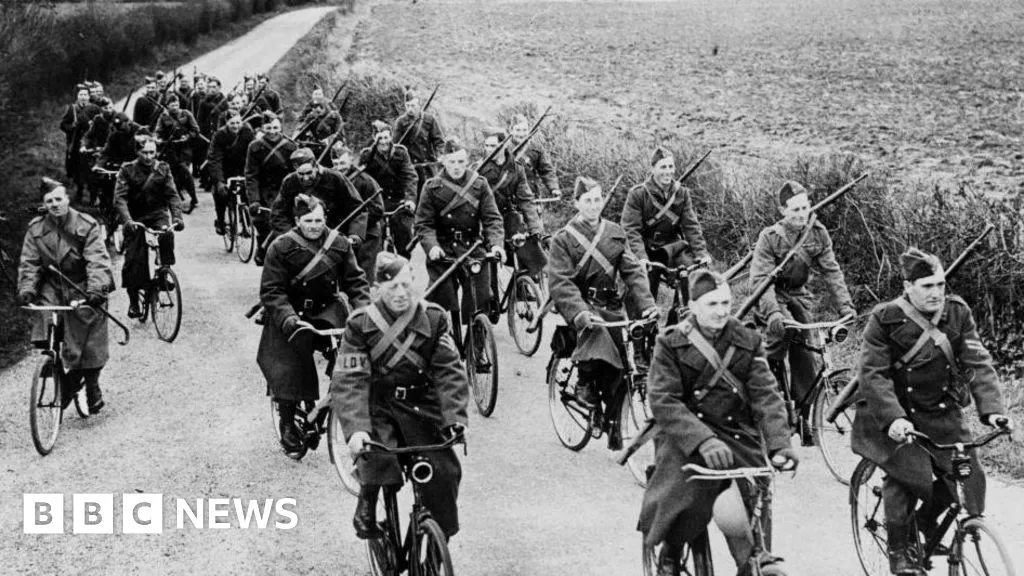A collection of World War Two Home Guard papers reveals the volunteer force was not "a load of duffers" but highly skilled soldiers, according to a historian.
The Home Guard was established in May 1940 as a last line of defence against a German invasion and was made up of unpaid soldiers who were ineligible for regular military service.
The papers belonged to Maj James Webster, the commanding officer of two Ipswich Home Guard battalions, and have been donated to Great War Huts.
Maj Webster's granddaughter, Helen Mitchell, said she was about to throw them away when she discovered their importance and the family decided to give them to the museum.
Taff Gillingham, the co-founder of Great War Huts near Bury St Edmunds, Suffolk, said the details in the papers ranged from training exercises to the names and addresses of recruits.
"The Home Guard's reputation is [that] they were amateurish, they lacked ammunition and were a load of duffers," Mr Gillingham said.
"But by 1943, they were not much different to the professionals; a lot were fit young fellows who were in jobs which exempted them joining the forces," he added.
Members of "Dad's Army" were usually men above or below the age of conscription and those exempt or unfit for front-line military service.
Maj Webster was one of the men whose work made him ineligible for conscription - he was a manager at the engineering business Crane Company, which produced parts for tanks during World War Two.
He became the commanding officer of D Company 9th Battalion Suffolk Home Guard and was also later D Company 11th Battalion's commanding officer.
"Commanding officers tended to be local businessmen and to come from town's big engineering companies, while members were drawn from all over town," said Mr Gillingham.
Initially ill-equipped, the documents reveal how the units became well-trained forces.
"The volume of paperwork shows how much training they had and at what an advanced level," the military historian said.
Another exercise does read "a bit like something from the TV sitcom Dad's Army", he said.
"They were meant to be learning how to blow up railway lines, but the head of the local railway refused to let them disrupt his whole schedule," Mr Gillingham said.
"He said, 'My fellows will set the charges on the railway lines and you all have to stand back and watch'."
However, while Dad's Army lays on the bungling for comedy effect, "it's a much cleverer piece of drama than it first appears; they always do the sensible thing right on time", the historian said.
The papers were kept in Mrs Mitchell's attic at her home in Truro, Cornwall, after she inherited them from her father, Maj Webster's oldest son Geoffrey.
When the roof sprung a leak, she rediscovered the archive.
"I thought I'm never going to sit down and read it, I don't know if this is significant - I have to admit I nearly threw it away," the 60-year-old said.
A friend suggested she posted details about it on a Home Guard social media site and "that's how I learned how rare they were".
She said: "I'm really delighted they have gone to the museum - my father valued those documents and I'm delighted someone else is valuing them."
The papers revealed Maj Webster's battalions running exercises with the Suffolk Regiment, as well as liaising with the British Resistance Organisation, an underground network which was top secret during the war and for years after.
Mr Gillingham is sure that if the Germans had invaded, the Home Guard "would have given a good account of themselves", alongside the regular Army.
He was also amazed to discover personal connections while going through the list of members' names and addresses.
"I bought my second-ever car, a Morris Oxford which I still have, from Reg Hood in 1985 and as I was leafing through the papers his name popped up 40 years later - he was in the 11th Battalion," he said.
"Another man lived at the same address in Christchurch St where my great school friend lived, so I visited that house all the time growing up - it's these sorts of threads you start to pull when you go through these local documents," he added.
